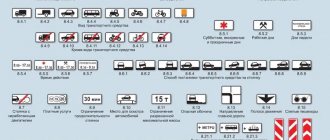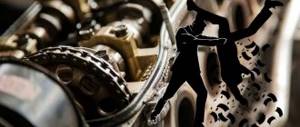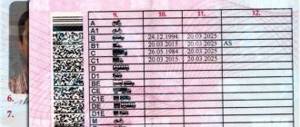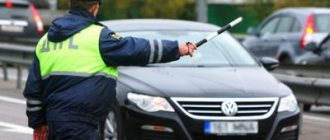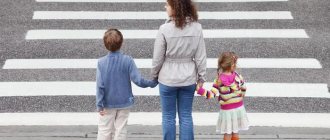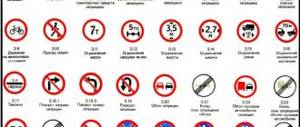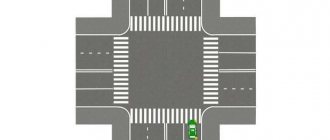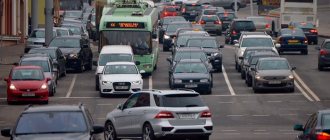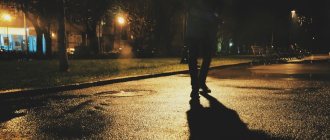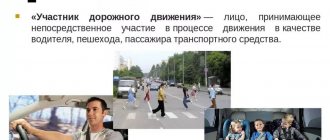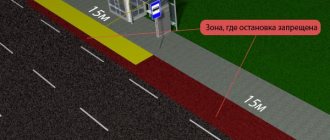Start of movement, maneuvering
The beginning of movement is the beginning of beginnings.
This topic in the exam papers covers more than three questions in one paper.
The first rule - before the first trip on the road, a novice driver must confidently master all the controls of the car -
to press the brake or gas pedal in time.
Know that it is necessary to turn on the direction indicators in advance when performing a maneuver, and turn them off immediately after its completion.
When entering the road from adjacent areas, give way to everyone who crosses your path.
Turning is carried out only from the leftmost lane; exceptions may only be for long road trains or narrow roadways.
Read more here
.
General provisions
First of all, it is enough to know that in Russia there is right-hand traffic and you can only move on the extreme right side of the road, and use your eye to determine the width of the roadway. The first step is to divide the road
in half and know your lane for traffic; the lane width according to GOST should be from 2.5 to 4 meters. The right of way for traffic is given to those who have their own lane free or are on the main road.
Read more here
Travel speed
Next, you need to be able to maintain the speed of your car corresponding to the speed of traffic on the road, and when moving slowly, not interfere with other road users, for which you can also get a fine. To join the flow you must be ready for it.
If you are afraid and cannot move at the set speed, or for any other reason, simply turn on the hazard lights, look in the rearview mirror and gradually begin to move to the right, and stop on the side of the road, or as far to the right as possible to the edge of the roadway, put up a warning triangle at a distance of at least 15 meters behind your car. If you are on a turn, the distance from your car to the sign must be at least 30 meters.
Permissible speed according to the Rules:
- In residential and courtyard areas no more than 20 km/h
- On roads in populated areas no more than 60 km/h
- Outside the populated area no more than 90 km/h ( there are restrictions for various vehicles)
- On the Motorway no more than 110 km/h and no less than 40 km/h (there are restrictions for various vehicles)
More details here
Traffic rules 2021
1.1 These Rules of the Road (hereinafter referred to as the Rules) establish a uniform procedure for road traffic throughout the entire territory of the Russian Federation. Other regulations relating to road traffic must be based on the requirements of the Rules and not contradict them.
1.2 The Rules use the following basic concepts and terms: “Highway”
- a road marked with sign 5.1 and having carriageways for each direction of travel, separated from each other by a dividing strip (and in its absence, by a road fence), without intersections at the same level with other roads, railway or tram tracks, pedestrian or bicycle paths.
“Road train”
is a mechanical vehicle coupled to a trailer(s).
“Bicycle”
is a vehicle, other than a wheelchair, which has at least two wheels and is generally propelled by the muscular energy of the occupants of the vehicle, in particular by means of pedals or handles, and may also have an electric motor of rated maximum power in continuous load mode not exceeding 0.25 kW, automatically switches off at speeds over 25 km/h.
“Cyclist”
is a person driving a bicycle.
“Bicycle path”
is a road element (or a separate road) structurally separated from the roadway and sidewalk, intended for the movement of cyclists and marked with sign 4.4.1.
“Driver”
is a person driving a vehicle, a driver leading pack animals, riding animals or a herd along the road.
A driving instructor is treated like a driver. “Forced stop”
is the cessation of movement of a vehicle due to its technical malfunction or danger created by the cargo being transported, the condition of the driver (passenger) or the appearance of an obstacle on the road.
“Hybrid vehicle”
is a vehicle that has at least 2 different energy converters (motors) and 2 different energy storage systems (on-board) for the purpose of propelling the vehicle.
“Main road”
- a road marked with signs 2.1, 2.3.1 - 2.3.7 or 5.1, in relation to the one being crossed (adjacent), or a road with a hard surface (asphalt and cement concrete, stone materials, etc.) in relation to the dirt road , or any road in relation to exits from adjacent territories. The presence of a paved section on a minor road immediately before the intersection does not make it equal in importance to the one it intersects.
“Daytime running lights”
are external lighting devices designed to improve the visibility of a moving vehicle from the front during daylight hours.
“Road”
is a strip of land or a surface of an artificial structure equipped or adapted and used for the movement of vehicles. The road includes one or more carriageways, as well as tram tracks, sidewalks, shoulders and dividing strips, if any.
“Road traffic”
is a set of social relations that arise in the process of moving people and goods with or without vehicles within the boundaries of roads.
“Road accident”
is an event that occurred during the movement of a vehicle on the road and with its participation, in which people were killed or injured, vehicles, structures, cargo were damaged, or other material damage was caused.
“Railway crossing”
is the intersection of a road and railway tracks at the same level.
“Route vehicle”
is a public vehicle (bus, trolleybus, tram) intended for transporting people on roads and moving along a set route with designated stopping places.
“Motor driven vehicle”
is a vehicle driven by an engine.
The term also applies to any tractors and self-propelled machines. “Moped”
is a two- or three-wheeled mechanical vehicle, the maximum design speed of which does not exceed 50 km/h, having an internal combustion engine with a displacement not exceeding 50 cubic meters.
cm, or an electric motor with a rated maximum power in continuous load mode of more than 0.25 kW and less than 4 kW. Quadricycles with similar technical characteristics are considered equal to mopeds. “Motorcycle”
is a two-wheeled motor vehicle with or without a side trailer, the engine displacement of which (in the case of an internal combustion engine) exceeds 50 cc.
cm or the maximum design speed (with any engine) exceeds 50 km/h. Motorcycles are considered tricycles, as well as quadricycles with a motorcycle seat or motorcycle-type handlebars, having an unloaded weight not exceeding 400 kg (550 kg for vehicles intended for the transport of goods), excluding the weight of batteries (in the case of electric vehicles), and the maximum effective engine power not exceeding 15 kW. “Settled area”
is a built-up area, the entrances to and exits from which are marked with signs 5.23.1 - 5.26.
“Insufficient visibility”
- visibility of the road is less than 300 m in conditions of fog, rain, snowfall, etc., as well as at dusk.
“Overtaking”
is the advance of one or more vehicles associated with entering a lane (side of the roadway) intended for oncoming traffic and subsequent return to the previously occupied lane (side of the roadway).
“Shoulder”
is an element of the road adjacent directly to the roadway at the same level with it, differing in the type of surface or marked out using markings 1.2, used for driving, stopping and parking in accordance with the Rules.
“Limited visibility”
is the driver’s visibility of the road in the direction of travel, limited by the terrain, geometric parameters of the road, vegetation, buildings, structures or other objects, including vehicles.
“Traffic hazard”
is a situation that has arisen during traffic in which continued movement in the same direction and at the same speed creates a threat of a traffic accident.
“Dangerous cargo”
- substances, products made from them, waste from industrial and other economic activities, which, due to their inherent properties, can pose a threat to human life and health during transportation, harm the environment, damage or destroy material assets.
“Advanced”
is the movement of a vehicle at a speed greater than the speed of a passing vehicle.
“Organized transportation of a group of children”
- transportation on a bus that is not a route vehicle, a group of children of 8 or more people, carried out without their parents or other legal representatives.
“Organized transport convoy”
is a group of three or more motorized vehicles following directly one after another along the same lane with constantly turned on headlights, accompanied by a lead vehicle with special color schemes applied to the outer surfaces and blue and blue flashing lights turned on. red flowers.
“Organized foot column”
is a group of people, designated in accordance with paragraph 4.2 of the Rules, moving together along the road in the same direction.
“Stopping”
is a deliberate cessation of the movement of a vehicle for up to 5 minutes, as well as for longer if this is necessary for boarding or disembarking passengers or loading or unloading the vehicle.
“Safety island”
is an element of road arrangement separating traffic lanes (including lanes for cyclists), as well as traffic lanes and tram tracks, structurally separated by curbstones above the roadway or marked by technical means of traffic management and intended to stop pedestrians when crossing the roadway.
The traffic island may include part of the dividing strip through which a pedestrian crossing is laid. “Parking (parking space)”
is a specially designated and, if necessary, arranged and equipped place, which is, among other things, part of a highway and (or) adjacent to the roadway and (or) sidewalk, shoulder, overpass or bridge, or is part of underpasses or underbridges spaces, squares and other objects of the road network, buildings, structures or structures and intended for organized parking of vehicles on a paid basis or without charging a fee by decision of the owner or other owner of the highway, the owner of the land plot or the owner of the corresponding part of the building, structure or structures.
“Passenger”
is a person, other than the driver, who is in (on) a vehicle, as well as a person who enters (gets on) the vehicle or exits (gets off) the vehicle.
“Intersection”
is a place where roads intersect, adjoin or branch at the same level, limited by imaginary lines connecting, respectively, the opposite, most distant from the center of the intersection, beginnings of curvatures of roadways.
Exits from adjacent areas are not considered intersections. “Changing lanes”
is leaving an occupied lane or occupied row while maintaining the original direction of movement.
“Pedestrian”
is a person who is outside a vehicle on the road or on a pedestrian or bicycle path and is not working on them.
Pedestrians include persons moving in wheelchairs without a motor, driving a bicycle, moped, motorcycle, carrying a sled, cart, baby stroller or wheelchair, as well as using roller skates, scooters and other similar means for movement. “Pedestrian path”
is a strip of land equipped or adapted for pedestrian traffic or the surface of an artificial structure, marked with sign 4.5.1.
“Pedestrian zone”
is an area intended for pedestrian traffic, the beginning and end of which are indicated by signs 5.33 and 5.34, respectively.
“Pedestrian and bicycle path (pedestrian and bicycle path)”
is a road element (or a separate road) structurally separated from the roadway, intended for the separate or joint movement of cyclists with pedestrians and indicated by signs 4.5.2 - 4.5.7.
“Pedestrian crossing”
is a section of the roadway, tram tracks, marked with signs 5.19.1, 5.19.2 and (or) markings 1.14.1 and 1.14.2 and allocated for the movement of pedestrians across the road.
In the absence of markings, the width of the pedestrian crossing is determined by the distance between signs 5.19.1 and 5.19.2. “Traffic lane”
is any of the longitudinal stripes of the roadway, marked or not marked with markings and having a width sufficient for the movement of cars in one row.
“Lane for cyclists”
is a lane of the roadway intended for the movement of bicycles and mopeds, separated from the rest of the roadway by horizontal markings and marked with sign 5.14.2.
“Advantage (priority)”
is the right to priority movement in the intended direction in relation to other road users.
“Obstacle”
is a stationary object in the traffic lane (faulty or damaged vehicle, defect in the roadway, foreign objects, etc.) that does not allow further movement along this lane.
A traffic jam or a vehicle stopped in this lane in accordance with the requirements of the Rules is not an obstacle. “Adjacent territory”
is the territory directly adjacent to the road and not intended for through traffic of vehicles (yards, residential areas, parking lots, gas stations, enterprises, etc.).
Movement in the adjacent territory is carried out in accordance with these Rules. “Trailer”
is a vehicle that is not equipped with an engine and is intended to be driven in conjunction with a power-driven vehicle.
The term also applies to semi-trailers and trailers. “Carriageway”
is an element of the road intended for the movement of trackless vehicles.
“Dividing strip”
is a road element, allocated structurally and (or) using markings 1.2, separating adjacent roadways, as well as the roadway and tram tracks and not intended for the movement and stopping of vehicles.
“Permitted maximum weight”
is the weight of the equipped vehicle with cargo, driver and passengers, established by the manufacturer as the maximum permissible.
The permissible maximum mass of a vehicle composition, that is, coupled and moving as one unit, is taken to be the sum of the permissible maximum masses of the vehicles included in the composition. “Traffic controller”
is a person vested with the authority to regulate traffic using the signals established by the Rules in accordance with the established procedure, and who directly carries out the said regulation.
The traffic controller must be in uniform and (or) have a distinctive sign and equipment. Traffic controllers include police officers and military motor vehicle inspectors, as well as employees of road maintenance services, those on duty at railway crossings and ferry crossings in the performance of their official duties. “Parking”
is the intentional interruption of the movement of a vehicle for a period of more than 5 minutes for reasons not related to the embarkation or disembarkation of passengers or the loading or unloading of the vehicle.
“Darkness”
is the period of time from the end of evening twilight to the beginning of morning twilight.
“Vehicle”
is a device designed to transport on roads people, goods or equipment installed on it.
“Sidewalk”
is an element of the road intended for pedestrian traffic and adjacent to the roadway or bicycle path or separated from them by a lawn.
“Give way (do not interfere)”
is a requirement that means that a road user must not start, resume or continue moving, or carry out any maneuver if this may force other road users who have priority over him to change direction. movement or speed.
“Road participant”
is a person directly involved in the traffic process as a driver, pedestrian, or passenger of a vehicle.
“School bus”
is a specialized vehicle (bus) that meets the requirements for vehicles for transporting children established by the legislation on technical regulation, and is owned by right of ownership or on another legal basis to a preschool educational or general education organization.
An “electric car”
is a vehicle driven solely by an electric motor and charged by an external source of electrical power.
1.3 Road users are required to know and comply with the relevant requirements of the Rules, traffic lights, signs and markings, as well as comply with the orders of traffic controllers acting within the limits of the rights granted to them and regulating road traffic with established signals.
1.4 Right-hand traffic for vehicles is established on the roads.
1.5 Road users must act in such a way as not to create a traffic hazard or cause harm. It is prohibited to damage or pollute road surfaces, remove, block, damage, or unauthorizedly install road signs, traffic lights and other technical means of traffic management, or leave objects on the road that interfere with traffic. The person who created the obstacle is obliged to take all possible measures to eliminate it, and if this is not possible, then by available means ensure that traffic participants are informed about the danger and report to the police.
1.6 Persons who violate the Rules are liable in accordance with current legislation.
Overtaking, oncoming traffic
Overtaking is considered to be the advance of one or more vehicles into the oncoming lane .
Advancing traffic within the carriageway of the same direction is not considered overtaking.
Before overtaking, the driver must be 100% sure that the maneuver is safe. This requires both experience and cold calculation. It’s better not to take risks if the speed is already more than 80 km/h and you have less than 5 years of experience.
Read more here
Driving through intersections
If you have practical driving
relatively normal, you just have to be careful not to interfere with those moving on the right, because they always have the advantage. The “right hand” advantage operates where there are no traffic lights, signs, markings, or other indicators that directly regulate traffic.
When approaching an intersection, look at the signs and be prepared to change lanes in advance. It is advisable to choose the route in advance.
When turning left, give way to oncoming people. Always and everywhere give way to pedestrians.
Read more here
In what order should I remember the signs?
For fruitful memorization, it is best to learn road signs in a certain sequence. This will allow you to systematize in your head the groups into which pointers are divided, to understand which designations are very important, and which ones are enough to remember and notice in time.
Round (prohibiting, prescriptive)
Round road signs are mandatory for all drivers, so they need to be memorized first. Prohibitory signs are always white (except for those prohibiting parking and stopping, they have a blue background) with a red line in a circle. They do not allow you to perform the action that is drawn in the center of the sign, and may have a crossing line. The prohibition does not apply to signs:
- the beginning or end of a settlement;
- crossroads;
- another white sign in the form of a circle with a black frame.
Prescriptive signs are also round, but they are blue. The signs have arrows indicating which way to go immediately after the sign at the intersection. A sign allowing a left turn also allows a U-turn if there is no prohibition sign.
To reinforce the information, remember that the white circle and red border around the perimeter of the sign prohibit, while the blue background prescribes. And the arrows depicted on it show the direction of the car. Be aware of rare exceptions.
Triangular (warning)
All triangle-shaped road signs are divided into two categories. They are similar in appearance, but have different meanings. Some are warning, others are regulatory. The latter streamline the flow of cars at intersections, thereby replacing traffic lights.
Warning signs are placed on unsafe roads and inform drivers about nearby objects.
Regulatory signs alert motorists when crossing railroad tracks or narrow sections. They are often found in regulated areas where there is a need to regulate traffic. At the intersection itself, you can find signs for the main road (a white square with a yellow border) and give way (an inverted triangle).
Squares and rectangles
Square and rectangular signs establish or limit travel modes on a specific road. Square signs use arrows or other symbols to indicate the direction of movement along the lanes. They also indicate residential and pedestrian areas, highways, bus stops and the like.
Signs of this type are not mandatory. But, most often, after the prescriptive sign there is a prohibitory sign, the command of which is mandatory. Therefore, it is better not to ignore the instructions of the pointers.
This group includes three subtypes:
- Information signs. They notify about what awaits the motorist ahead: a populated area, a river, repair work, various objects, and so on.
- Service marks. These signs are created for the convenience of the driver and show the distance to the nearest car wash, gas station, etc.
- Additional information signs. Installed in conjunction with the main road sign. They show the direction of action of the main sign, distance, etc.
Location of vehicles on the roadway
When turning left or making a U-turn, take the extreme left position on your side of the road.
That is, the road
divided by gender.
Yours, accordingly, is on the right side of the roadway. When turning right, take the extreme right position and turn only in a small radius, which means from the extreme right to the extreme right position
on the road.
The same goes for turning left. Look in advance at the signs indicating the direction of movement in the lanes. Read more here
How to quickly and easily learn traffic signs for a novice driver
To quickly learn such a large number of signs and not get confused, you need to use the right study pattern. In this case, it is necessary to separate all signs according to their shape, type and color. To study all the signs, you need to start with their correct division:
- Additional information signs;
- prescriptive signs;
- service marks;
- prohibition signs;
- information signs;
- signs of special regulations;
- priority signs;
- warning signs.
Each type of sign has its own requirements regarding color, shape and designation. To quickly remember all the signs, it is very important to divide them into these categories.
Distribution by signs:
- Blue color – recommendations and instructions;
- red color – cancellation or ban.
It is important that in this case it does not matter whether the entire sign is filled with this color or just its border.
Round
A red sign of this shape always indicates a ban. The basic rule is that regardless of what is in the circle, it must be performed without fail.
Triangular
This type of sign always indicates a warning. Most often, the background is white and the border is red.
Types of vehicles
Each type of transport has its own designations. If, in addition to the designation of the vehicle, the carrying capacity is also indicated, then it is indicated below it.
Cancel signs
Cancellation is indicated by a red line through it or 4 black diagonal lines.
By studying the signs by their types, you can quickly understand all their diversity. Moreover, for this it is not at all necessary to memorize them, because you can easily interpret them.
Prohibiting
Such signs always have a white background with a red border, with the exception of those prohibiting parking. This group is used to enter/cancel some restrictions. They are located in front of those sections of roads where certain restrictions are introduced/lifted.
Warning
Like the previous ones, they have a red border with a white background. Most often they are made in the shape of a triangle. Such signs warn of possible danger. They are installed within a populated area at a distance of 50-100 m, or outside populated areas 150-300 meters before a dangerous section of the route.
It is important to highlight the signs that indicate the direction of the turn. These have a rectangular shape and a horizontal position. The arrows on them are red. They are installed on detours or sharp turns.
Prescriptive
They have a round shape and a blue background. Unlike prohibition signs, everything inside the circle must be followed. These types of signs are installed in those places where it is necessary to begin to comply with their instructions. Exactly the same sign, only crossed out, indicates the end of its action.
Special instructions
Like the previous ones, they have a blue background with a white border. They talk about special regulations on a specific type or section of roads. Such signs are placed at the beginning and end of the traffic zone. Almost all of them are installed in pairs.
These signs are best studied individually!
A priority
Such signs can have different shapes and colors. There are only 13 of them, so it is best to learn them separately too. Their main task is to determine the order in which cars pass. Often installed at road intersections and intersections.
Information
They can also be of different colors and shapes, but are often rectangular with a blue background. They carry information regarding the distance of various objects, including populated areas or data on traffic patterns.
Among other things, they can talk about upcoming difficulties along the way.
Service
They look like a blue rectangle with a white square in the middle. On a white background there is a black image that indicates the object, and the numbers below it indicate the distance to it. Used to inform about the distance to service stations, gas stations, cafes, etc.
Such signs are installed before entering the territory of the specified facility.
Additional action
These symbols appear as a horizontal rectangle, often with a black border and a white background. Such signs are a clarification or limitation to the signs to which they are applied. That is why they are always installed together with other signs.
In the case when several ordinary and several additional signs are installed at the same time, then they must be considered in pairs to the nearest sign.
Thus, using this simple scheme for distributing all signs into groups, you will be able to quickly study all the signs that you may encounter on the road and thereby protect your life and other road users.
Traffic lights and traffic controller signals
Traffic light
cancels the actions of priority signs, but does not cancel the indication of signs prescribing the direction of movement, and
the traffic controller
can cancel the instructions of the traffic light, any road signs and markings, but do not forget that traffic on the lanes must comply with
the Rules for driving through intersections
.
If there is no traffic light or traffic controller, look at the signs or markings
.
Signs are more important than markings, and a temporary sign is more important than a permanent sign.
Read more here
How to learn road signs?
If there is no good driving practice, then most residents of the country may encounter difficulties while memorizing road signs.
Remembering and distinguishing road signs is really not easy, given their number and the correct meaning, which you also need to know. Usually, driving school teachers in this matter recommend starting with the basics, that is, you should simply memorize the pictures, trying to remember their meaning. Also, an additional effect is provided by the way, while walking or as a passenger, to pay attention to the signs, mentally saying what each of them prohibits, requires, and so on.
As practice shows, there are two main ways to remember road signs well and quickly, which are in every locality, on country roads and even, sometimes, in the forest. It's about visualization and using a smartphone.
Visualization. In order to use this method, when studying road signs, it is recommended to divide them into groups and try to externally remember each sign, while studying what it means. Of course, this method does not replace the standard study of road signs, but it can help to significantly simplify it, making it easier and more accessible to all driver candidates.
Although, all road users need to know the road signs, as this will help avoid possible road accidents. Whenever you go outside, it is best to mentally repeat the signs. This will allow you to remember them as quickly as possible and then easily navigate through them while driving a car and without being distracted at this moment.
Subsequence. Each person who is faced with the task of learning road signs must divide them into groups and memorize each one step by step, understanding how it differs from the others.
Thus, signs can be divided into several groups: round, triangular or square. In addition, it is important to remember the marking line, which also plays an important role. To find out how easy it is to learn road signs, you can talk to a private driving instructor. And he will probably mention the most modern method of using web services and mobile applications. It is also beneficial for the instructor that the candidate driver quickly learns the signs and is able to obtain a driver’s license, so they are really ready to accommodate those who wish to do so.
Smartphone. Today, life without a smartphone is unimaginable for many, so you can use this gadget to quickly learn signs. There are a large number of different applications that can help in this situation. Compared to a brochure, such applications have a lot of advantages, the main ones being accessibility and constant updating of data.
Conclusion. The question of how to learn road signs is answered well by special extensions and specific resources on the Internet. The main thing is to have desire and a certain amount of perseverance!
Stopping and parking
We drive further and think about where we can stop or park without violating traffic rules. You cannot stop or even pick up or drop off passengers at railway crossings or in tunnels. Also, stopping is prohibited on bridges, overpasses, overpasses and under them if there are less than three lanes for traffic in a given direction . The correct choice of a place to stop or park on the road, where the width of the roadway depends
or the distance from your car to the continuous marking line must be at
least 3 meters . Where stopping is prohibited, parking is prohibited. More details here
